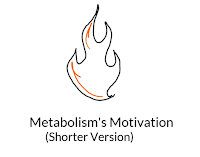Metabolism’s motivation: The thermodynamics of life.
- What drives the standard repertoire of reactions known as metabolism?
- What are the underlying principles that govern these reactions?
- In a universe that is constantly increasing in entropy, how does the human body maintain order at an intricate, molecular level?
If these questions intrigue you, read on to unravel a few of biochemistry’s secrets and gain a slighter deeper understanding of the reactions that constitute life itself!
The human body like any other system requires energy to do work. We derive energy from the food we eat and use it to maintain a living state.
How much work can I extract from a system?
The oxidation of carbohydrates, fats and proteins liberates energy. However, only some amount of the energy liberated can be used to do work. How much work can I extract form such oxidations? Gibbs free energy (), a thermodynamic quantity, tells us exactly this. Free energy is the amount of energy available for doing work. It is defined as the enthalpy (total energy of the system) minus entropy times temperature (the amount of energy work cannot be extracted from).
Thus, after completion of a reaction, the change in Gibbs free energy () between final and initial states tells us how much usable energy we have obtained because of the reaction.
measures the total change in entropy caused by a reaction. Note that a positive corresponds to a decrease in total entropy and a negative corresponds to an increase in total entropy. Irrespective of whether the entropy of the system and the surroundings are increasing or decreasing, this total entropy of the universe is always increasing.
The importance of imbalance or non-equilibrium for life (Yes, you read that right!)
The for a reaction at equilibrium is zero. For the proof refer to this Wikipedia article. Only non-equilibrium reactions produce a positive or negative value. Since, a positive corresponds to a decrease in total entropy, such reactions require energy to drive them. Thus, only non-equilibrium reactions with a negative value provide free energy to perform work.
The human body needs free energy to do work such as maintenance of concentration gradients, muscle contraction and nerve impulse transmission. Thus, maintaining a state of non-equilibrium is essential for life. A non-equilibrium state provides a thermodynamic driving force. This driving force pushes the reaction towards equilibrium.
Like a sloping piece of land drives the flow of water, a thermodynamic driving force drives the flow of metabolites in a particular direction in the human body. The free energy liberated from these reactions is then stored in high energy compounds such as adenosine triphosphate (ATP).
The rate of flow of metabolites in the body is known as flux.
The human body is an open system
The human body is an open system. We exchange matter and energy with our surroundings. We take in high enthalpy low entropy compounds and convert them to low enthalpy high entropy compounds that we give out. The free energy that we obtain from these compounds is used to maintain a non-equilibrium steady state within the body.
The field of irreversible thermodynamics and an introduction to the steady state.
Now that we understand the enormous importance of non-equilibrium to a living system, lets dip our toes into the field of irreversible thermodynamics. In contrast to classical thermodynamics (aka equilibrium thermodynamics) which deals with reversible process in an closed system, this field deals with irreversible processes in an open system.
The steady state in irreversible thermodynamics refers to the state in which the open system produces maximum work. It can be defined as follows :
The maintenance of a constant flux (of metabolites) in an open system (such as the human body) is known as the steady state.
It is interesting to note that the steady state abides by Le Chatelier’s principle. That is, reactions tend to compensate external changes in order to maintain steady state concentrations. Thus, steady state is analogous to equilibrium. This is clearly seen in how the excess of a metabolite often inhibits the reaction that produces it and drives the reaction that utilizes it as a substrate!
Closed system (Classical Thermodynamics) : Equilibrium :: Open system (Irreversible Thermodynamics) : Steady State
How does the body maintain a steady state?
Steady state is maintained by:
a) The irreversible nature of the rate determining step of the metabolic pathway.
b) Saturation of enzymes catalyzing the rate determining step.
The rate determining step
The rate determining step is the slowest step in the pathway. It is an irreversible reaction that occurs earlier on in the metabolic pathway. An irreversible reaction is one whose substrate and product concentrations are very far from from equilibrium. In attempting to reach equilibrium, large losses of free energy occur, making this type of reaction essentially irreversible.
Being irreversible, the reaction commits the substrate to that pathway and forces it to traverse in only one direction. Such a step is seen earlier on in the pathway to increase efficiency by preventing unnecessary synthesis of metabolites further along the pathway.
The rate determining step is irreversible. Hence, it commits the substrate to a particular pathway. Being the slowest step in the pathway, it determines the rate.
Enzymes catalyzing rate determining steps
The enzymes catalyzing rate determining steps in the pathway have low values in comparison to their substrate concentration. The Michaelis constant () is numerically equal to the substrate concentration at which the reaction rate is half of its maximum possible rate. It is a measure of enzyme affinity to the substrate. A low value means that the enzyme has high affinity for substrate and undergoes saturation at lower substrate concentrations. Thus, for enzymes with low values, the enzyme is saturated and an increase in substrate concentration has no effect on reaction rate. Even during changes in substrate concentrations, a constant flux (steady state) can be maintained.
The rate of the rate determining step is determined not by substrate concentration but by the rate of enzyme activity itself.
ATP and non - spontaneous reactions the ultimate OTP
A reaction that is non-spontaneous may be driven forward by a reaction that is spontaneous by performing the two reactions simultaneously!
Consider a pair of weights. When the lighter weight is connected to a pully, it tends to move downwards. When the heavier weight is connected to a pully it also tends to move downwards. However, when both the weights are attached to the pulley on either side, the lighter weight move upwards while the heavier weight moves downwards.
Similarly endergonic reactions (analogous to the lighter weight) are forced to occur by coupling them with highly exergonic reactions (analogous to the heavier weight).

Source : pexels.com
The overall reaction is spontaneous as :
All of life’s activities depend on coupling of this kind. The hydrolysis Adenosine triphosphate (ATP) is one such highly exergonic reaction. Thus, it drives other very useful endergonic reactions in the body and maintains order at the molecular level!
NOTE
This article attempts to describe biochemical reactions and thus has made the following assumptions.
Conditions in a biological environment :
a) Constant temperature
b) Constant pressure
c) Nearly constant volume
Thus, biochemical reactions are isothermal,isobaric and sustain negligible volume changes.
Sources
- For a longer version of this article head to this blogpost.
- Elements of Physical Chemistry by Julio de Paula and Peter Atkins
- Harper’s Illustrated Biochemistry 31st Edition
- Biochemistry by Donald Voet and Judith G. Voet
- Lehninger Principles of Biochemistry, Fourth Edition by David L. Nelson, Michael M. Cox, and Rabbi David Nelson, PhD






